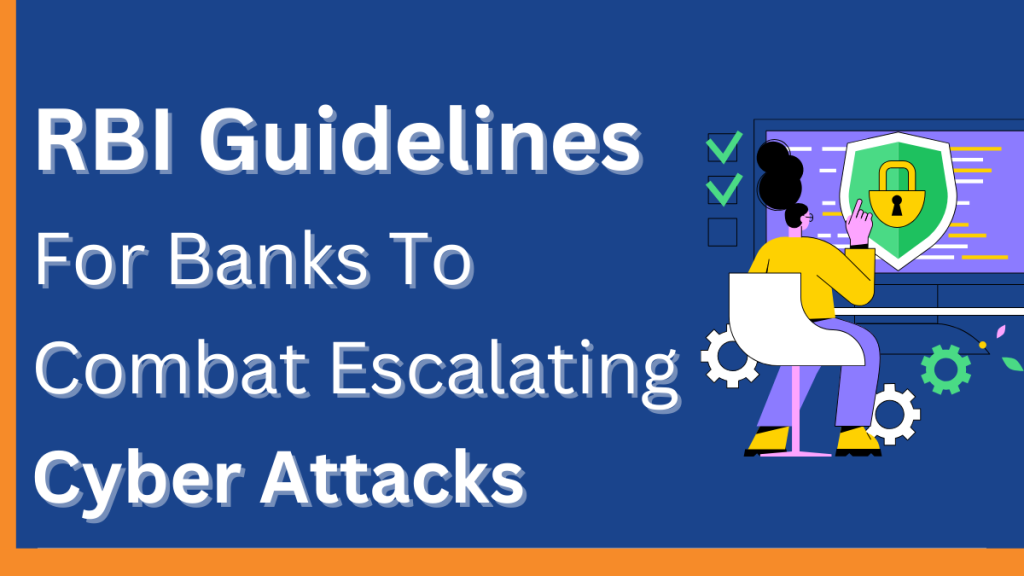Nowadays, the rapid advancements in technology have brought numerous benefits and convenience to people’s lives. However, these developments have also given rise to new challenges, particularly in the world of cybersecurity. The Indian banking sector, like many others around the world, faces the escalating cyber threats of cyberattacks. The Reserve Bank of India (RBI), as the country’s central banking institution, plays a very important role in protecting the financial system and has implemented a series of strategies to act as a foil to these threats effectively.

Understanding the Cyber Threat Landscape
To get rid of the most dangerous cyber threats, it is important that you have a clear-cut knowledge about the ever-changing landscape where these threats live in. You should know that cyber attackers are becoming more and more sophisticated. They have begun to use different methods and tactics to breach systems. They hope to get unauthorized access to sensitive data by doing this. A number of cyber threats like phishing attacks, ransomware attacks, Distributed Denial of Service (DDoS) attacks, and insider threats pose serious risks to the Indian Banking sector.
- Phishing attacks usually involve fake attempts to get sensitive information such as usernames, passwords, and credit card details by pretending to be someone trustworthy. These attacks often use fake emails, websites, or messages to fool people.
- Ransomware attacks are another serious threat. This is where cybercriminals can get access to a person’s data and demand a bribe or ransom for it. Such attacks can create chaos for banking and result in financial losses.
- Another problem that can occur is a DDoS attack. In such a case, they can overwhelm a targeted system or network with a flood of traffic. By doing that, it can become inaccessible to the actual user. This in turn, can create financial damage and loss of reputation for banks.
- There are also insider threats, which can come from employees or contractors who have access to sensitive information.
Building a Robust Cybersecurity Framework
Recognizing the growing importance of cybersecurity, the RBI has made the development of a strong framework to curb cyber risks an important part of its agenda. This framework focuses on three core pillars: prevention, detection, and response.
Prevention
Prevention is the first line of defense against cyber threats. The RBI has established guidelines and regulations to ensure that banks implement adequate preventive measures. These measures encompass a range of actions, including:
- Strong Password Policies: Enforcing the use of complex passwords and regular password changes to minimize the risk of unauthorized access.
- Network Segmentation: Dividing the network into multiple segments to contain potential intrusions and limit the lateral movement of cyber attackers.
- Encryption of Sensitive Data: Protecting sensitive data through encryption techniques, making it unreadable to unauthorized individuals.
- Regular Security Audits: Conducting frequent audits to identify vulnerabilities and potential weaknesses in the banking network.
- Employee Awareness and Training: Raising awareness among bank employees about common cyber threats through training programs to enhance their ability to recognize and report potential risks.
Detection
Timely detection of cyber threats is crucial to minimize their impact. The RBI has implemented a centralized monitoring system to enable banks to report any suspicious activities in real-time. This system allows for the prompt identification of potential threats, empowering banks to take immediate action. Additionally, the RBI encourages banks to harness advanced technologies like artificial intelligence and machine learning to enhance their detection capabilities. These technologies can analyze vast amounts of data, identify patterns, and detect anomalies that might indicate a cyberattack in progress.
Response
Despite preventive measures, cyberattacks can still occur. With this in mind, the RBI mandates that banks have a well-defined incident response plan in place. These plans provide a structured framework for responding to cybersecurity incidents effectively. Key elements of an incident response plan include:
- Incident Containment: Taking immediate steps to contain the attack and prevent further damage or unauthorized access.
- Impact Assessment: Evaluating the extent of the breach and assessing potential risks and losses to determine the appropriate response.
- System Recovery: Restoring affected systems and processes to their normal state, ensuring that business operations can resume promptly.
- Stakeholder Communication: Communicating and coordinating with relevant stakeholders, such as customers, employees, and regulatory authorities, to keep them informed of the incident and its impact.
- Post-Incident Analysis: Conducting a thorough analysis of the incident, identifying lessons learned, and implementing measures to prevent future occurrences.
To ensure that banks are prepared to handle cyber incidents, the RBI conducts regular drills and simulations to test their response capabilities. These exercises help identify any gaps in the response strategies and enable continuous improvement.
Strengthening Regulatory Compliance
Regulatory compliance plays a vital role in bolstering cybersecurity defenses. The RBI has established strict requirements for banks to adhere to its Cybersecurity Framework. This framework sets forth the minimum standards for securing digital transactions, safeguarding customer data, and protecting critical banking infrastructure. The RBI conducts periodic audits to evaluate banks’ compliance with these requirements. Non-compliance can result in penalties and other enforcement actions, encouraging banks to maintain robust cybersecurity measures and continuously enhance their security posture.
Collaboration with Banks and Industry Stakeholders
The RBI recognizes that a collaborative approach is essential to effectively tackle cyber threats. Accordingly, it actively engages with commercial banks and other industry stakeholders to facilitate the sharing of best practices, insights, and threat intelligence. This collaboration allows banks to benefit from the collective wisdom of the industry and stay informed about emerging cyber threats and mitigation strategies.
To promote information sharing and collaboration, the RBI encourages the establishment of sectoral Computer Emergency Response Teams (CERTs). These CERTs serve as dedicated entities responsible for collecting and disseminating cyber threat information among banks and other financial institutions. By sharing timely and relevant information, CERTs enhance the sector’s overall cybersecurity resilience.
Promoting Research and Innovation
The RBI recognizes that research and innovation are fundamental to stay ahead of cyber threats. It actively encourages banks and organizations to invest in research and development to strengthen their cybersecurity defenses. By fostering innovation in cybersecurity technologies and methodologies, the sector can continuously adapt to new threats and mitigate emerging risks effectively.
Collaboration with academic institutions, research organizations, and industry experts is pivotal in promoting research and encouraging innovation in the field of cybersecurity. The RBI engages in partnerships and supports initiatives that drive research in cybersecurity, aiming to develop cutting-edge solutions to address evolving cyber threats.
Creating Cybersecurity Awareness
Building a cyber-resilient society requires creating awareness among bank customers and the general public. The RBI places a strong emphasis on educating individuals about common cyber threats, safe online practices, and the importance of securing personal information. To achieve this, the RBI conducts regular awareness campaigns through various channels, including social media, seminars, workshops, and publications.
These campaigns focus on empowering individuals with the knowledge and skills necessary to protect themselves from cyber threats. By raising awareness about the risks and providing practical guidance, the RBI aims to foster a safer digital environment for everyone.
Conclusion
The escalation of cyber threats in the banking sector poses significant risks to both banks and their customers. However, the RBI has taken proactive measures to counter these threats through comprehensive strategies. By focusing on prevention, detection, and response, strengthening regulatory compliance, promoting collaboration, fostering research and innovation, and creating cybersecurity awareness, the RBI is playing a pivotal role in safeguarding the Indian financial system.
As cyber threats continue to evolve, the RBI’s strategies will adapt and enhance to match emerging challenges. By staying at the forefront of cybersecurity protection, the RBI ensures that the Indian banking sector remains resilient against cyber threats, offering customers a secure and reliable banking experience in an increasingly digital world.
To help you prepare 50% faster for competitive exams, ixamBee provides a free Mock Test Series and all the Current Affairs in English and Current Affairs in Hindi in the BeePedia capsules for GA Preparation. You can also get the latest updates for Bank PO, Bank Clerk, SSC, RBI Grade B, NABARD, and Other Government Jobs.
Also Read
Why is SEBI Called a Watchdog of the Indian Securities Market?
Impact of Globalization on Agriculture















